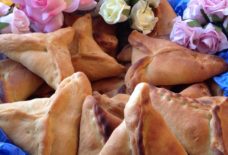Dance, Storytelling, and Resistance with Shoruq Children’s Debke Troupe
Shoruq Children’s Debke. Photo by Brooke AndersonBY: Abigail Keyes/Ambassador Blogger
This spring, the Shoruq Children’s Debke Troupe is touring the United States, performing Palestinian debke and hip-hop, and sharing their stories of life in the Dheisheh Refugee Camp in the West Bank.
The 18 young men and women are all between the ages of 12 and 16 years old, and express their stories, struggles, and hopes through traditional and theatrical debke performances. Six of the girls also perform original hip-hop songs, in both Arabic and English, which challenge stereotypes about girls and women, as well as their wishes for the future and their dreams for the Palestinian people.
Based in the Dheisheh Refugee Camp near Bethlehem, Shoruq trains children, youth, and professionals in creating music, radio, and video programming to document, preserve, and develop their cultural heritage. The Shoruq Organization helps these Palestinian refugees by offering free legal aid and psychosocial support to refugee children.
Shoruq Children’s Debke. Photo by Brooke AndersonWhen touring the US, the Shoruq Children’s Debke Troupe often performs on stages at high schools and junior high schools, educating the students there about the Palestinian experience and the dances in their program. Their travel, lodging, and food are facilitated by non-profits and host families throughout the country, particularly through the Middle East Children’s Alliance (MECA), which has a long-standing relationship with Shoruq.
Their lives back in the refugee camp are quite limited by US standards, with their average day consisting of going from home to school to Shoruq and back home. The right to return is a recurring theme in their performances; both in the debke and the girl’s hip hop shows.
Storytelling and Preserving Culture Through Debke
Debke, for the unversed, is a form of folk dance from Palestine, Syria, Lebanon, and Jordan, and parts of Iraq. It’s traditionally performed in lines, with the dancers either holding hands or with their arms over each other’s shoulders. The line almost always travels in a circle to the left. The dance steps are heavily weighted, but also incorporate hops and jumps. Some debke dancers show off their athleticism through their leaps and intricate footwork.
The dance company performs both theatrical and traditional debke. Their costumes are hand-made and embroidered in the traditional style in Palestine. Their current tour includes two sets.
Shoruq Children’s Debke. Photo by Brooke AndersonThe first set begins in 1948, when 750,000 Palestinians were expelled from their homes during the creation of Israel. One dancer is seen grieving, her back hunched, while the others perform behind her to a song that tells of the early days of Palestinian exile. A celebratory dance to the traditional song “Dala’ouna” follows, with songs of grief and struggle coming after. While the songs sing of homesickness and strife, the high energy of the dancing expresses the resilience of not only of the youthful performers themselves, but also of the Palestinian people.
The second debke performance uses traditional Palestinian songs and a wide variety of traditional debke steps. The songs were all recorded at the Shoruq media center back at the Dheshieh refugee camp, and features singer Yacoub Shaheen, winner of the fourth season of Arab Idol.
Some of the dancers have been in the company for as long as five years. Directing them is Munther Issa, who trains the dancers and choreographs the debke with fellow dancer Ali. In an interview with the KPFA radio station in Berkeley, California, Issa said that dance is a way to communicate and express himself. He also said that dance has changed how he looks at the world, and provides a much-needed outlet for stress. The company meets for rehearsals three times a week.
Hip-Hop as Resistance
Their recent show also includes a performance by their girl’s hip-hop company. Aged 12 to 16, they write their own songs and produce the music themselves at the Shoruq media center. Nadin, 15, told me that the hip-hop project allows her to express her feelings about the problems in the camp and what it’s like to live under occupation. Two of the girls remarked that they both love the song “Watani,” because “it talks about what homeland means” to them.
Shoruq Hip-Hop. Photo by Brooke AndersonThe two also said that they love the work of Palestinian rapper Tamer Nafar and hip-hop artist Shadia Mansour because of how they both put the Palestinian experience into words.
Education through Art
When I asked the dancers of their first impressions of the US, they remarked at how big it is and how freely they could travel between cities. Back in Palestine, Israeli soldiers and checkpoints limit their movement.
Tamer, a 14-year-old, said that many people he talked to didn’t know what or where Palestine was, and that coming to the US is a great opportunity to communicate and educate. Nancy, 15, answered that she sees these performances as a chance to tell people about Palestinian culture and traditions.
All of the dancers said in some way that they will preserve their nationality, using their art and dance as peaceful resistance, while maintaining their culture and sharing their heritage.
Thank you to the dancers and performers in Shoruq, as well as to Josie Shields-Stromsness at MECA for passing on my questions to them.
Abigail Keyes is a freelance writer based in Berkeley, California. She has blogged for PsychCentral.com, non-profits, and corporate wellness companies. For eight years, she worked as an analyst for the US Federal Government, following Middle Eastern politics and media. She is the author of The Salimpour Compendium Vol 1, a book on the history of Middle Eastern dance, and she is co-editor of a collection of essays on the popular Netflix series Jessica Jones. You can find her at akeyeswriting.com and her blog at akeyesdance.com/blog.









